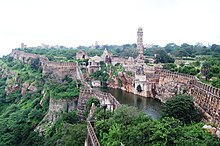| Chitrangada Mori | |
|---|---|
| Reign | 7th century |
| Dynasty | Mori Kingdom |
| Religion | Hinduism |

Chitrangada Mori was a ruler of the Mori Kingdom. [1] [2]
Chitrangada Mori laid the foundation of his capital at Chittor Fort, which is the largest fort in India. [3] He reigned in the 7th century AD, and the ruins of his palace still are present today. [4] Chittorgarh was then known as Chitrakot, which changed to Chittorgarh in colloquial language. [3]
Chitrangada Mori was possibly succeeded by Bappa Rawal, the Rajput ruler of Guhila dynasty after several conflicts with Arabs. [5]